Ruf Automobile
Ruf Automobile GmbH is a German car manufacturer that manufactures and engineers original vehicles using unmarked Porsche chassis, specifically known as bodies in white. The cars are built from the ground up as completely new cars, using these bare chassis, and assembled using Ruf-made parts and materials (e.g. BTR, CTR2, RT12), instead of badge engineering or disassembly of existing cars. This means the company is officially recognized as a manufacturer by the German government. As such, all Ruf models have certified Ruf VIN and serial numbers, and are recognized as production models, rather than modified Porsches. Ruf is historically known for its record breaking 211 mph CTR, and is the largest, most renowned company to make Porsche performance enhancements. Though primarily a manufacturer, Ruf has also made a name for itself operating as a car tuner, a specialist in customer-requested Porsche-to-Ruf conversions (e.g. Turbo R conversions), and a restorer of classic Porsche and Ruf models. Ruf carries out service and crash repair, as well.
 | |
| Type | GmbH |
|---|---|
| Industry | Automotive |
| Founded | 1939 |
| Headquarters | Pfaffenhausen, Germany |
Key people | Alois Ruf Sr. (founder) Alois Ruf Jr. |
| Products | Automobiles Automotive parts |
| Website | www.ruf-automobile.de |
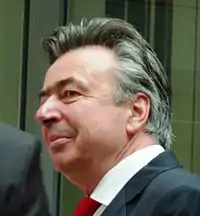
VIN
Ruf Automobile GmbH operated as a car manufacturer and a car tuner at the same time for some models. For example the famous CTR (1987–1996) was manufactured only 29 times from bodies in white, at the same time about 20-30 cars were built from customers' cars. It is possible to distinguish between manufactured cars and tuned cars by looking at the VIN (vehicle identification number). A RUF VIN starts with "W09" whilst a Porsche VIN starts with "WP".
History
The company was founded in 1939 in Pfaffenhausen, Germany as "Auto Ruf" by Alois Ruf Sr. as a service garage and was eventually expanded to include a full-service gas station in 1949. Ruf began experimenting with vehicle designs of his own in the late 1940s, and in 1955 designed and built a tour bus, which he marketed around Germany. The positive response it received led to Ruf expanding his business again by starting his own separately owned bus company.
Alois Sr.'s involvement in the car industry had a distinct effect on his son, Alois Ruf Jr., who became a sports car enthusiast. In 1960, Alois Jr. began servicing and restoring Porsche automobiles out of his father's garage. Following Alois Sr's. death in 1974, 24-year-old Alois Jr. took control of the business and focused on his passion: Porsche vehicles, and especially the 911. A year later in 1975, the first Ruf-enhanced Porsche came to life.
Ruf debuted their first complete model in 1977, a tuned version of Porsche's 930 with a stroked 3.3 litre motor. This was followed in 1978 by Ruf's first complete non-turbo Porsche, the 911 SCR. It was a naturally aspirated 911 with a stroked 3.2 litre motor producing 217 horsepower. Numerous customer orders were placed for this vehicle.
In the years since, the company has made a major mark on the automotive world by producing exceptionally powerful and exclusive Porsche-based production models. The 1987 Ruf CTR achieved a top speed of 339 km/h (211 mph) in April 1987 and set the record as the world's fastest production car for its time; in 1988 it even reached 342 km/h (213 mph). Its successor, the 1995 Ruf CTR2, had clocked a top speed of 350 km/h (217 mph), making it for a brief moment the fastest road-legal production car in the world in the mid '90s, until the McLaren F1 broke the record in 1998 at 241 mph, thus making the CTR2 the second-fastest production car of the decade. However, the CTR2 cost only a fraction of the price of the F1.[1][2][3]
In April 2007, Ruf released the new CTR3 to celebrate the company's new plant in Bahrain, and as a 20th anniversary celebration of the original CTR and successor to the CTR2. At the 2010 Geneva Motor Show, Ruf also showcased the RGT-8, the first production V8-powered 911 in history.
Ruf models
Current models
| Modern models | |||||
|---|---|---|---|---|---|
| Model | Duration of production | Based on | Engine | Top speed | Image |
| CTR3 Clubsport[4] | 2012–present | Ruf-designed body | 3.7L twin-turbocharged flat-6 777 PS (571 kW; 766 bhp) 980 N⋅m (723 lb⋅ft) |
380 km/h (240 mph) | 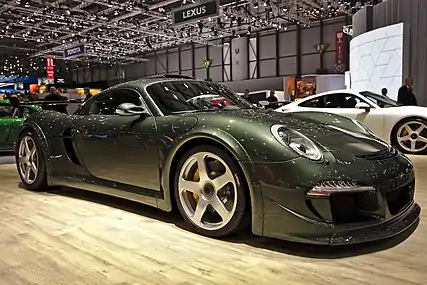 |
| Turbo Florio[5] | 2015-present | Porsche 991 Targa 4 | 3.8L twin-turbocharged flat-6 645 PS (474 kW; 636 bhp) 835 N⋅m (616 lb⋅ft) |
330 km/h (210 mph) | 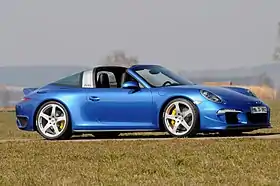 |
| CTR Anniversary[6] | 2017-present | Ruf-designed body | 3.6L twin-turbocharged flat-6 710 PS (522 kW; 700 bhp) 880 N⋅m (649 lb⋅ft) |
360 km/h (220 mph) | 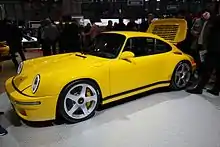 |
| SCR 2018[7] | 2018-present | Ruf-designed body | 4.0L naturally aspirated flat-6 510 PS (375 kW; 503 bhp) 470 N⋅m (347 lb⋅ft) |
320 km/h (200 mph) | .jpg.webp) |
| GT[8] | 2019–present | Porsche 991 | 3.0L twin-turbocharged flat-6 515 PS (379 kW; 508 bhp) 645 N⋅m (476 lb⋅ft) |
320 km/h (200 mph) | .jpg.webp) |
| Classic models | |||||
|---|---|---|---|---|---|
| Model | Duration of production | Based on | Engine | Top speed | Image |
| RCT Evo[9] | 1993–present | Porsche 964 | 3.6L turbocharged flat-6 425 PS (313 kW; 419 bhp) 570 N⋅m (420 lb⋅ft) |
320 km/h (200 mph) | 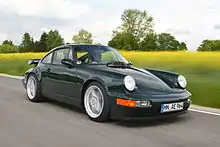 |
| Turbo R[10] | 1998–present | Porsche 993 | 3.6L twin-turbocharged flat-6 490 PS (360 kW; 483 bhp) 650 N⋅m (479 lb⋅ft) |
330 km/h (210 mph) | .jpg.webp) |
| R56.11[11] | 2011–present | Porsche 356 | 2.4L naturally aspirated flat-4 170 PS (125 kW; 168 bhp) 220 N⋅m (162 lb⋅ft) |
225 km/h (140 mph) | |
Past models
Please be aware that this table is still incomplete.
| Model | Duration of production | Based on | Engine | Top speed | Image |
|---|---|---|---|---|---|
| Turbo 3.3[12] | 1975-? | Porsche 930 | 3.3L turbocharged flat-6 303 PS (223 kW; 299 bhp) 412 N⋅m (304 lb⋅ft) |
262.8 km/h (163.3 mph) |  |
| SCR (SCR 3.2) | 1978-1981 | Porsche 911SC | 3.2L naturally aspirated flat-6 217 PS (160 kW; 214 bhp) 280 N⋅m (207 lb⋅ft) |
255 km/h (158 mph) |  |
| BTR | 1983–1989 | Porsche 930 | 3.4L turbocharged flat-6 374 PS (275 kW; 369 bhp) 480 N⋅m (354 lb⋅ft) |
305 km/h (190 mph) | 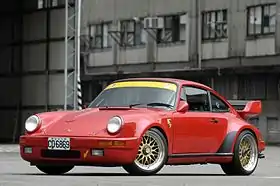 |
| CTR "Yellowbird" | 1987–1996 | Porsche 911 Carrera 3.2 | 3.4L twin-turbocharged flat-6 469 PS (345 kW; 463 bhp) 553 N⋅m (408 lb⋅ft) |
342 km/h (213 mph) | 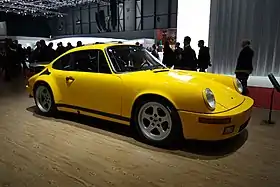 |
| BTR III (antecedent to BTR2) | 1988–1989 | Porsche 964 | 3.4L turbocharged flat-6 408 PS (300 kW; 402 bhp) 480 N⋅m (354 lb⋅ft) |
290 km/h (180 mph) |  |
| BR2 | 1991-1992 | Porsche 964 Carrera | 3.3L turbocharged flat-6 360 PS (265 kW; 355 bhp) 465 N⋅m (343 lb⋅ft) |
303 km/h (188 mph) |  |
| CR2 (one-off) | 1991 | Porsche 964 Carrera 2 | 3.6L turbocharged flat-6 290 PS (213 kW; 286 bhp) |
- |  |
| CR4 (one-off) | 1991 | Porsche 964 Carrera 4 | 3.6L turbocharged flat-6 290 PS (213 kW; 286 bhp) |
- |  |
| RCT | 1993 | Porsche 964 | 3.6L turbocharged flat-6 370 PS (272 kW; 365 bhp) |
305 km/h (190 mph) |  |
| BTR2 | 1993-1998 | Porsche 993 | 3.6L turbocharged flat-6 420 PS (309 kW; 414 bhp) 590 N⋅m (435 lb⋅ft) |
308 km/h (191 mph) |  |
| CTR2 | 1996-1997 | Porsche 993 | 3.6L twin-turbocharged flat-6 "entry-level": 520 PS (382 kW; 513 bhp) 685 N⋅m (505 lb⋅ft) SPORT: 580 PS (427 kW; 572 bhp) 780 N⋅m (575 lb⋅ft) |
350 km/h (220 mph) | .jpg.webp) |
| 3400S | 1999-2002 | Porsche 986 (Boxster) | 3.4L naturally aspirated flat-6 310 PS (228 kW; 306 bhp) 360 N⋅m (266 lb⋅ft) |
278 km/h (173 mph) |  |
| RGT | 2000–2004 | Porsche 996 | 3.6L naturally aspirated flat-6 "entry-level": 385 PS (283 kW; 380 bhp) RS: 395 PS (291 kW; 390 bhp) |
307 km/h (191 mph) | .jpg.webp) |
| RTurbo | 2001–2005 | Porsche 996 | 3.6L twin-turbocharged flat-6 variant 1: 520 PS (382 kW; 513 bhp) 740 N⋅m (546 lb⋅ft) variant 2: 550 PS (405 kW; 542 bhp) 780 N⋅m (575 lb⋅ft) |
350 km/h (220 mph) | 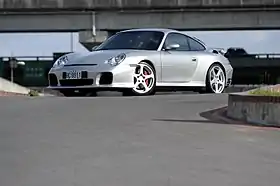 |
| 3600S | 2002 | Porsche 986 (Boxster) | 3.6L naturally aspirated flat-6 325 PS (239 kW; 321 bhp) 370 N⋅m (273 lb⋅ft) |
278 km/h (173 mph) |  |
| Rt 12 | 2004–2012 | Porsche 997 | 3.6L twin-turbocharged flat-6 variant 1: 530 PS (390 kW; 523 bhp) variant 2: 560 PS (412 kW; 552 bhp) 3.8L twin-turbocharged flat-6 variant 1: 685 PS (504 kW; 676 bhp) variant 2: 737 PS (542 kW; 727 bhp) |
over 350 km/h (220 mph) | 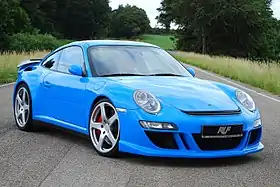 |
| RGT (2nd generation) | 2005–2011 | Porsche 997 | 3.8L naturally aspirated flat-6 451 PS (332 kW; 445 bhp) 420 N⋅m (310 lb⋅ft) |
- |  |
| RK Spyder[13] | 2005–2008 | Porsche 987 (Boxster) | 3.8L supercharged flat-6 440 PS (324 kW; 434 bhp) 470 N⋅m (347 lb⋅ft) |
over 300 km/h (190 mph) |  |
| RK Coupé[14] | 2006–2007 | Porsche 987c (Cayman) | 3.8L supercharged flat-6 440 PS (324 kW; 434 bhp) 470 N⋅m (347 lb⋅ft) |
over 300 km/h (190 mph) |  |
| R Kompressor | 2006–2009 | Porsche 997 | 3.6L supercharged flat-6 435 PS (320 kW; 429 bhp) 470 N⋅m (347 lb⋅ft) 3.8L supercharged flat-6 460 PS (338 kW; 454 bhp) |
- |  |
| CTR3 | 2007–2012 | Ruf-designed body | 3.7L twin-turbocharged flat-6 691 PS (508 kW; 682 bhp) 890 N⋅m (656 lb⋅ft) |
375 km/h (233 mph) | 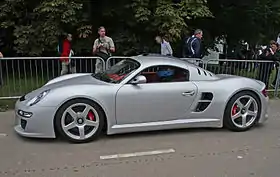 |
| 3400 K | 2007-? | Porsche 987c (Cayman) | 3.4L supercharged flat-6 400 PS (294 kW; 395 bhp) 440 N⋅m (325 lb⋅ft) |
- | 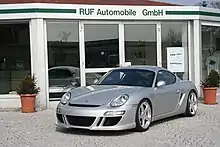 |
| Rt 12S | 2009-? | Porsche 997 | 3.8L twin-turbocharged flat-6 cheerful approximation from 3746 cm3 685 PS (504 kW; 676 bhp) 880 N⋅m (649 lb⋅ft) |
- | .jpg.webp) |
| Dakara | 2009 | Porsche 955 (Cayenne) | 4.5L twin-turbocharged V8 600 PS (441 kW; 592 bhp) 890 N⋅m (656 lb⋅ft) |
- | 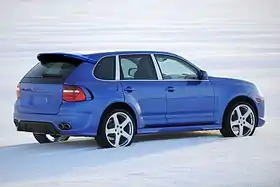 |
| RGT-8 | 2010 | Porsche 997 | 4.5L naturally aspirated V8 550 PS (405 kW; 542 bhp) 500 N⋅m (369 lb⋅ft) |
317 km/h (197 mph) |  |
| Rt 12R | 2011–2012 | Porsche 997 | 3.8L twin-turbocharged flat-6 730 PS (537 kW; 720 bhp) 940 N⋅m (693 lb⋅ft) |
- |  |
| RGT-8 (new version) | 2012–? | Porsche 991 | 4.5L naturally aspirated V8 550 PS (405 kW; 542 bhp) 500 N⋅m (369 lb⋅ft) |
318 km/h (198 mph) |  |
| Rt 35 | 2012–2013 | Porsche 991 | 3.8L twin-turbocharged flat-6 630 PS (463 kW; 621 bhp) 825 N⋅m (608 lb⋅ft) |
- |  |
| Rt 35 S | 2013–pr.? | Porsche 991 | 3.8L twin-turbocharged flat-6 650 PS (478 kW; 641 bhp) 840 N⋅m (620 lb⋅ft) |
- | 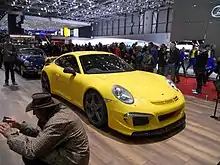 |
| Rt 35 Roadster | 2013–pr.? | Porsche 991 | 3.8L twin-turbocharged flat-6 630 PS (463 kW; 621 bhp) 825 N⋅m (608 lb⋅ft) |
- |  |
| 3800S | 2013–2017 | Porsche 981 (Boxster) | 3.8L naturally aspirated flat-6 420 PS (309 kW; 414 bhp) 450 N⋅m (332 lb⋅ft) |
303 km/h (188 mph) |  |
| RGT 4.2 | 2015–2016 | Porsche 997 GT3 RS 4.0 | 4.2L naturally aspirated flat-6 525 PS (386 kW; 518 bhp) 500 N⋅m (369 lb⋅ft) |
322 km/h (200 mph) |  |
| RtR[15] | 2015–2017 | Porsche 991 | 3.8L twin-turbocharged flat-6 variant 1: 645 PS (474 kW; 636 bhp) variant 2: 802 PS (590 kW; 791 bhp) 990 N⋅m (730 lb⋅ft) |
350 km/h (220 mph) | 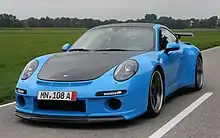 |
| TurboR Limited | 2016 | Porsche 993 | 3.6L twin-turbocharged flat-6 620 PS (456 kW; 612 bhp) 750 N⋅m (553 lb⋅ft) |
339 km/h (211 mph) | 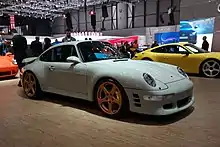 |
| SCR (SCR 4.2) | 2016–pr.? | Porsche 993 | 4.2L naturally aspirated flat-6 525 PS (386 kW; 518 bhp) 500 N⋅m (369 lb⋅ft) |
322 km/h (200 mph) | 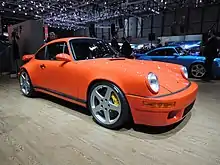 |
| Ultimate | 2016–pr.? | Ruf-designed body | 3.6L twin-turbocharged flat-6 590 PS (434 kW; 582 bhp) 720 N⋅m (531 lb⋅ft) |
339 km/h (211 mph) | .jpg.webp) |
Prototype and Concept models
- RXL
- eRuf Model A
- CTR (2017)
- RGT8
- Rodeo
eRuf electric vehicles
The eRuf Model A is an all-electric sports car made by Ruf Automobile. The car is powered by a UQM Technologies[16] propulsion system (a UQM PowerPhase 150). The car has a top speed of 225 km/h (140 mph)[17] and is capable of producing 150 kW (204 PS; 201 hp) and 649 N⋅m (479 lb⋅ft) of torque.[18] Estimated range per charge is 250–320 km (155–199 mi), depending on performance level, using iron-phosphate, lithium-ion batteries built by Axeon of Great Britain.[19] The power and torque produced by the 3-phase motor can be used to recover almost as much power as it can put out. During coasting the engine works as a generator producing electricity to charge the batteries.[20] Ruf announced that it hoped to begin production of the eRuf in the autumn of 2009.[21] This did not happen, and at the 2009 Geneva Motor Show, Ruf announced a new model, the eRUF Greenster, with limited production planned to commence at the end of 2010.[22]
In video games
Ruf models have historically appeared in many large racing video game franchises as a substitute for the Porsche models they are based on due to Porsche's exclusive licensing in video games.[23] Starting with the release of Need for Speed: Porsche Unleashed in 2000, Porsche entered an exclusivity deal with Electronic Arts (EA) which meant that Porsche models would only appear in EA's titles, most notably the Need for Speed franchise and the Real Racing series. The only exceptions to this were a number of games in the Forza and Project Gotham Racing series due to sub licensing arrangements made between EA and their games' respective developers, Turn 10 Studios and Bizarre Creations. Other large video game franchises, however, including Gran Turismo, Project CARS, Assetto Corsa, Asphalt, Test Drive, The Crew, Driver: San Francisco, Driveclub and a few Forza games used Ruf models in place of Porsche. This circumvented Porsche's licensing as Ruf is considered by the German government to be a full fledged manufacturer, and as such Ruf models have unique VINs.[24] The exclusivity deal between Porsche and EA ended in 2016, leading many franchises to stop featuring Ruf models in favor of Porsche.[25]
References
- John Lamm. Supercars. pp. 10–11. ISBN 0-7603-0794-6.
- Egan, Peter (2016-05-29). "In 1987, The World's Fastest Cars Couldn't Catch A 211-mph Twin-Turbo Ruf". Road & Track. US. Retrieved 2016-08-31.
- Auto, Motor und Sport 25/1988
- "RUF CTR3 Clubsport". RUF Automobile. Retrieved 2019-05-25.
- "RUF Turbo Florio". RUF Automobile. Retrieved 2019-05-25.
- "RUF CTR Anniversary". RUF Automobile. Retrieved 2019-05-25.
- "RUF SCR 2018". RUF Automobile. Retrieved 2019-05-25.
- "RUF GT". RUF Automobile. Retrieved 2019-05-25.
- "RUF RCT Evo". RUF Automobile. Retrieved 2019-05-25.
- "RUF Turbo R". RUF Automobile. Retrieved 2019-05-25.
- "RUF R56.11". RUF Automobile. Retrieved 2019-05-25.
- "RUF Turbo 3.3" (PDF). Auto Motor und Sport. 1977. Retrieved 2020-01-25.
- "RUF RK Spyder". STUDIOTORINO. Retrieved 2020-01-26.
- "RUF RK Coupé". STUDIOTORINO. Retrieved 2020-01-26.
- "RUF RtR". RUF Automobile. Retrieved 2020-01-26.
- "UQM Technologies". Uqm.com. Retrieved 2009-04-29.
- Nick Hall (2008-11-13). "eRuf Model A (electric Porsche 911)". MSN Cars. Archived from the original on 2010-03-01. Retrieved 2009-01-17.
- Jake Holmes (October 2008). "Ruf eRuf Concept Model A - Car News". Car and Driver. Archived from the original on 2009-01-24. Retrieved 2009-01-17.
- "Electric Drive Transportation Association". Electricdrive.org. Retrieved 2009-04-29.
- "eRUF Concept Model A 2008 "Emotion without Emission"" (PDF) (Press release). RUF Automobiles. 2008-10-10. Retrieved 2009-01-17.
- Jake Holmes (October 2008). "Ruf eRuf Concept Model A - Car News". Car and Driver. Retrieved 2009-01-17.
- Abuelsamid, Sam (4 March 2009). "Geneva 2009: Ruf Greenster evolves the electric Porsche concept". Autoblog.com. Retrieved 2010-11-27.
- Reilly, Luke (2015-02-08). "EA, We Need to Talk About Porsche". IGN. Retrieved 2018-11-08.
- "EA's exclusive licensing deal with Porsche is over". Polygon. Retrieved 2018-11-08.
- "Is Porsche Pushing RUF Out of Racing Games?". GTPlanet. 2017-05-04. Retrieved 2018-11-08.
